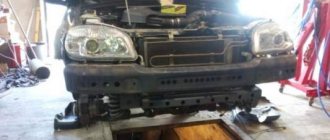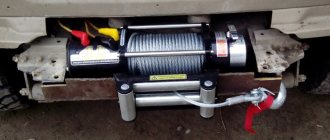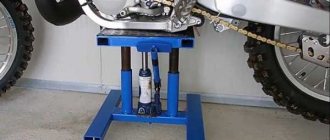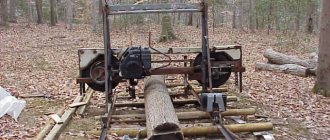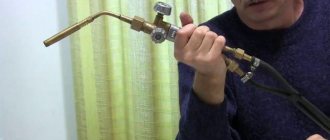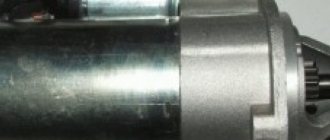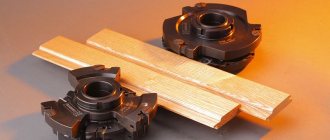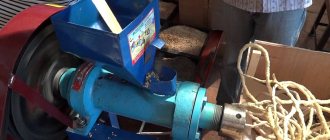A winch is a necessary element of vehicle equipment if you plan to travel off-road. It can also come in handy in urban conditions if a wheel gets stuck, but in difficult terrain, where there is no way to call for help and the car is stuck on the very bridge, the winch is indispensable.
Often SUVs are equipped with this device at the assembly stage or you can buy it. But a homemade winch for a car, if you look at it as an ordinary task, is completely within the capabilities of anyone and does not require an engineering education.
In addition, such a device can replace a construction crane if everything is calculated in detail, a drawing and a work diagram are made. This will be more effective than using a hoist. Such a mechanism can be installed on a trailer or MZSA trailer.
Homemade winches from various materials
A winch can be made from a variety of readily available materials. These are mainly spare parts from automotive equipment, other devices and mechanisms whose service life has expired. Finding available materials - metal pipes, iron sheets, different types of cables is also not a problem. There are several types of winches that are increasingly popular.
Winch from starter
A DIY starter winch is a convenient option for saving money. In order for a homemade winch from a starter to realize its potential, you will need:
- 12 volt gear starter (easy to find from VAZ 2106 or 2110).
- As a gearbox (reduction), you can get by with a drill assembly.
- For the casing that covers the space between the engine and the gearbox, a piece of pipe (for example, PVC) is suitable. It should be easy to disassemble for access inside and maintenance of the device.
- The drum is often made of durable (from 120 mm) steel pipe and sheet iron (2-3 mm).
- Gears, cable, electrical wiring.
To make such a winch from a starter, a platform is made from a sheet of metal, and components are attached to it. The drum seats are then welded to it. The gearbox is welded so that the input shaft is on top. An adapter for the starter is attached to the gearbox, and gear teeth are attached to the input shaft. For this, the flywheel crown is used. Then the starter and wiring are attached.
Winch from wiper motor
To make a winch, you can use a motor that previously used a windshield wiper or windshield wipers for its work. These devices are capable of showing good results and lifting weights up to 300 kg.
It is popular to use such a mechanism to mount a blade on a vehicle of sufficient cross-country ability (for example, Niva) - for clearing snow or similar tasks.
Winch from KAMAZ ratchet
A truck brake ratchet (a self-leveling mechanism for adjusting brakes) is a popular option for a homemade winch. Many people use the KAMAZ version of the ratchet, since KAMAZ is widespread and parts from it are easy to find. Such a mechanism can lift from 400 kg to 2 tons. The popularity of this option is due to the use of a worm gear in the mechanism.
For production you will need:
- Two rear ratchets of the truck.
- Two hooks.
- Cable 4-5 mm thick.
- Fist for releasing brake pads.
- Bolt for fastening the hook.
Worm gear winch
The main convenience of a worm gearbox, in addition to its load capacity, is the ability not to use a drum brake. One of the popular options for such a winch is a gearbox from trolleybus doors. It has enough gear ratio for fairly heavy loads and is easy to mount.
What can be useful for a winch made from scrap materials
To make a homemade winch, any scrap and any working parts that are within reach will be useful. The source of the motor for the electric winch can be a chain saw, a motor scooter or an automatic washing machine (if the motor is running). Cuttings of thin-walled and thick-walled pipes, bearings, gears, starters from old cars, ratchets from trucks, a motorcycle clutch disc, etc. will be useful. You will only have to buy a cable and something not very expensive. A welding machine and a lathe will suffice as equipment.
Recommendations for use
The long service life of a homemade winch directly depends on compliance with the following conditions:
- high-quality bearing lubrication;
- reliable fixation of the mechanism on the foundation;
- installation of chain pairs in one plane;
- checking parts before starting;
- monitor the load and do not exceed the permissible limits;
- control the movement of cargo;
- do not touch the cable if it is under load;
- watch the turns as the cable wraps around the drum.
In this article we will talk about how to make an electric winch from a starter with your own hands. A manual winch is much easier to make, but its use is not as effective as an electric one. We select all the necessary parts, study the instructions, and try to repeat everything in our garage. The garage must have a 12 V power source. Because using a car battery will not provide you with constant energy. It is enough for 2-3 minutes of operation of such a winch.
We create a simple lifting mechanism with our own hands
But if you need a mechanism for cargo urgently or for a one-time use, but you don’t have time to buy it in stores and you’re sorry for the money, we’ll tell you how to make a chain hoist with your own hands. It’s good if you have threaded rods, bearings, a block, a cable, a hook, and a gear in your workshop. It will take a little time: you need to fit the bearings onto the stud. It is advisable to fix the nut from the stud so as not to waste some of the effort on turning the peculiar shaft. The end of the pin can be equipped with a gear, thus making a more convenient manual drive.
We throw a cable over the block and fasten it to a support, but at the other end we attach a hook on which we will hang the load. You can also fix a sling system at the end of the cable if the nature of the load does not allow it to be attached to the hook. In principle, the simplest version of the chain hoist is ready. All that remains is to get to work, observing safety precautions, which are the same for all mechanisms, both purchased and homemade. Carefully check all elements for integrity before work, and during work do not make sudden movements, lift the load smoothly, and, of course, do not stand under a suspended load.
Safety regulations
Do not step over any stretched rope. During work, you cannot do without specialized gloves that have sealing elements on the fingertips, or high-quality canvas gloves. The use of regular gloves is strongly discouraged.
Do not forget about the possibility of the cable breaking, as this is extremely dangerous for both equipment and people. It is advisable to place a load in the center to ensure safety. The cable is fastened only to strong, high-quality elements.
Before using a car winch, the cable must be completely unwound, after which it is carefully, but as tightly as possible, wound back with the necessary tension. This avoids entanglement, which can cause the drum to jam. Full unwinding ensures maximum efficiency, low damage and proper elasticity
Full unwinding ensures maximum efficiency, low damage and proper elasticity.
Device types
Classification is the first thing you need to know about the traction device. They are divided depending on the type of design, drive and technical features. Some types of winches are easy to make yourself - this is the simplest mechanism with a manual drive. And complex structures will work reliably only if they are manufactured in a factory.
This specificity must be taken into account when choosing a type for self-production. There are removable and stationary winches. The first option can be removed from the car, carried out maintenance or used for other economic purposes.
Classification depending on the type of drive:
- Manual. Its advantages are its small size and relatively light weight. The work is carried out according to the drum principle. The cable is pulled onto a separate reel, and it is rotated by hand. The disadvantage lies in the limitation of the mass with which work can be done - no more than 1 ton.
- Mechanical. The drum with the cable is rotated by the machine's engine. The design is heavy, so car enthusiasts rarely use it.
- Electric. The best option is for the drum to be driven by an electric motor. The latter is powered by a battery or the vehicle's electrical system. The load capacity in this version is 4 tons.
- Hydraulic. The design is complex, but it works silently and with great traction force. But such systems are unreliable and expensive. Another drawback is that it is impossible to make a hydraulic drive system yourself.
Calculation of the chain hoist
Before manufacturing a chain hoist, it is necessary to calculate the main technical characteristics of the load-lifting structure. Calculations are required for drawing up drawings and are made according to the parameters of the working premises and the weight of the load.
To determine the loads affecting the block system during operation, it is necessary to calculate the parameters acting on individual blocks:
The equation used to find the moments of force is as follows: SM * R = SC*R + l*SC*R + N* g*d/2, where:
When calculating, it is also recommended to determine the efficiency of the remaining bypass rollers, depending on the design features of the lifting mechanism.
Types of homemade winches
Winches are divided into three main types: electric, mechanical and hydraulic. The fourth is manual. Each design has its pros and cons, both during the design and installation process, and during operation.
A hand winch is a popular option. The downside is that its use requires physical effort. The advantage is complete autonomy, no electricity required. In order to pull out a car, all you need is a firmly standing tree or just a crowbar driven into the soil. Hand winches are divided into 3 main types:
- Lever.
- Assembly and traction.
- Drums.
Lever ones use a ratchet or ratchet mechanism. Their main drawback is the traction force - from 0.7 to 4 tons. The advantage is that there is no need for rigid fixation; you can work on weight. This is the simplest type of winch.
Assembly-traction winches are almost similar to lever winches, but are not equipped with a drum. This is the most common type, and not only for cars.
Drums are the most effective option. The drum can be toothed or worm. The first wears out much more slowly.
Advantages of drum winches: traction force from 0.25 to 5 tons; a brake that is activated in an emergency situation; cable length (up to 40 meters with a diameter of 15 mm). If the thickness is greater, you can pull out any heaviest car from anywhere, and the cable will not break, even if you give full throttle.
Drum winches use:
- Single speed gear drive. The main gear is attached to the drum, which takes on the main load. The clutch houses the drive gear. The gain factor is the ratio of the number of their teeth. The gain is also affected by the length of the lever - the longer it is, the less force is required. This winch allows one person to pull out a car weighing up to 3 tons.
- Multi-speed gear drive. Such a mechanism consists of two or several pairs of gears, due to which the gain increases many times over. The downside is low speed under heavy loads.
- Worm drive. Rarely used for cars in “camping” conditions due to high maintenance requirements - the worm pair requires constant lubrication. In addition, this type does not work most effectively with high loads and is not suitable for heavy vehicles. The advantage is compactness.
Electric winches
The most popular type of homemade winch for a car. This is justified by its power, ease of operation and reliability. In addition, this option does not require large expenses for assembly and installation on the car. Such an electric winch can operate either on its own autonomous electric motor or receive power from a generator installed in the car. In the second case, you need to look and calculate the installation so that power is supplied from it not only to the winch, but also to the vehicle systems.
A popular option is using a starter; such a winch is easier to build with your own hands. The Zilov ST230 starter is often used.
Mechanical winches
Mechanical winches are powered by a motor. Manufacturers often install them already at the stage of completing SUVs (for example, such an automobile self-extractor is installed on an army UAZ). This winch is connected to a shaft and operates through a transmission. The winding speed can be changed by lowering or increasing the speed. The main advantages are stability and traction power. The main disadvantage is that it only works with a working engine.
Often this option is used for installation on MTZ - skidding, for example, forests is much easier.
Hydraulic winch
The most structurally complex option, since in addition to the standard ones it must contain additional elements: a hydraulic drive, a tank and an oil pump. In addition, the device can hardly be called compact. Assembly and installation will require considerable effort. However, such a winch consumes much less energy than electric power, and its power is much higher.
Nuances
However, this tool has its limitations. Homemade winches are not entirely safe, and therefore are not suitable for lifting loads, since they do not have a stopper. However, having made this tool once, you will not be afraid that your iron friend will get stuck off-road. At any moment, a homemade winch can pull an SUV out of a ditch, no matter how deep it is.
Driving over rough terrain, even in an all-terrain SUV, can create a lot of problems. To increase cross-country ability, additional equipment is often installed on vehicles, which allows them to overcome difficult sections of the road. Let's take a winch as an example. Today, a winch is installed on UAZ and many other cars. If desired, a winch can be made with your own hands and installed not only on the Niva, but also on other SUVs. It is worth considering that a homemade winch can be intended for lifting loads and other purposes. For example, there are portable versions that can be installed on a wheel or other element of the car. Let's look at the features of making a winch, its types and many other points in more detail.
Do-It-Yourself Winch From a Screwdriver
Do-it-yourself small-sized winch from a starter
One of the favorite methods for producing a homemade electric winch is the introduction of an auto starter. This device is equipped with a powerful high-torque electric motor with a supply voltage of 12 volts, which allows you to use a winch on a jeep.
At the production stage, you should keep in mind the limitations:
- The starter is designed for short-term operation. This does not mean at all that it will immediately burn out under prolonged load, but the motor housing does not provide sufficient cooling of the winding. If you intend to use the winch frequently and the work periods will be long, take care of additional cooling. For example, weld aluminum corners onto the body as cooling ribs;
- The car starter
is started using a retractor relay with a bendix.
You don't need a solenoid for the winch, but a contact starter wouldn't hurt. The current at the contacts will be enormous, and it is better to abandon the standard switching circuit. Depending on the gearbox used, the bendix should be fixed by welding in the position of greatest engagement or removed from the solenoid relay
;
Winch
Winch
it is driven using a 2.2 kV grinder. Before that, there was a 1.5 kV three-thousander engine that could not be pulled.
The side walls are made of sheet iron 3-5 mm. Thinner sheets may become deformed when the cable is pulled under load.
The most important part is attaching the drum axis. For this, powerful bearings with podiums from some mechanism from the times of the USSR were used. You can find such spare parts at scrap metal collection points or in the workshops of abandoned factories.
The podiums are welded to the side walls. If you managed to find only bearings, weld the outer race. Nothing will happen to the rolling mechanism; the bearings simply cannot be replaced.
We connect the gearbox with the electric motor from the starter, put the winch in good shape: we clean the welds with a grinder, remove rust, and cover the tool with paint.
The design has been tested to lift weights up to 200 kg. In this version, two gearboxes are used - from an electric drill and a homemade one from a gas electric valve. It feels like there will be enough traction for another 100-150kg.
The video shows an example of a winch using a starter.
How to use the device?
Be sure to provide for the possibility of reversing the power supply to the winch. Reverse is necessary in such devices. Since this is a regular car electric motor, changing “” to “-” will change the direction of shaft rotation.
Let the power starter be old, from the solenoid relay
. And the start buttons come from ancient electromechanical devices. The button block can provide for polarity reversal.
If the winch is used in a car, do not connect it to the standard battery with the engine turned off. With a good load, you will drain the battery in 10-15 minutes.
The dimensions allow the winch to be placed on the bumper of an SUV prepared for off-road use.
Do-it-yourself winch - price
If you have your own garage or shed with rubbish accumulated over several years of home plumbing, the cost of the product is determined by the price of a can of spray paint for final finishing.
Basically, the components are as follows:
- Starter from a VAZ 2101 car without a planetary gearbox (working, lying in the garage);
- A gearbox in a housing from a domestically produced electric drill (purchased at a flea market for the equivalent of 0.5 vodka);
- A piece of water pipe found in a barn;
- Metal for the frame, body walls, drum. Also found in a barn;
- Drum axle - purchased at a scrap metal collection point for pennies;
- The rope and hook were purchased at a tourism supply store.
Taking into account the cost of a new winch, the cost of the issue can be considered zero. At the same time, the owner can vouch for the safety of the device. Every detail and weld is personally checked by the manufacturer.
Purpose of the device
When driving off-road, a driver may encounter an insurmountable obstacle. Then the car will have to be pulled out of the mud or sand with something. A winch is the ideal tool for this. Some vehicles have the device installed on the front bumper from the factory. Purchasing a ready-made winch can cost a lot of money, so it makes sense to make it yourself using improvised materials.
A factory or homemade winch with a manual drive (or with an electric drive from a starter) allows you to pull out a car without a tow. Experienced car enthusiasts prefer home-made devices that fully meet their needs. Factory winches often fail or cost a lot of money.
There are different types of structures. It is impossible to say unequivocally which one is better. Different types are used for different situations and purposes.
Do-it-yourself winch with manual or electric drive
If you have the skills to work with a welding machine, you can make a winch yourself from scrap materials.
Making a winch with your own hands
You will need:
- Rectangular pipe for making the frame;
- Pipe or finished drum shaft;
- Sheet metal for drum discs, thickness 3 mm;
- Threaded rods M10-M12, 24 cm long – 6 pieces, nuts;
- Tube with a diameter of Ø14 – 6 identical pieces of 20 cm;
- Large and small sprockets and chain;
- Hubs for attaching the drum to the shaft and for attaching the shaft to the frame;
- Lever for manual drive, gasoline or electric motor, powered by ~220 V mains or car battery;
- A cable of the required length with a carabiner at the end;
- Welding machine and electrodes;
- Grinder with cutting and grinding disc;
- Paint and primer for metal;
Set of wrenches.
Winch manufacturing technology:
- According to the drawing, a 20x20 mm rectangular pipe for the frame is cut with a grinder. All connections made perpendicularly are obtained by cutting the workpieces at an angle of 45 degrees.
- Lay out the workpieces on a flat surface. The winch frame is welded using a spot welding machine at the junction of the workpieces. Check the perpendicularity of the corners and the consistency of the dimensions, after which the seams are completely welded. Weld a sheet metal platform with longitudinal grooves for attaching the drive motor. Remove scale and burrs with an angle grinder grinding wheel.
- Sand the frame, cover it with a metal primer, and after drying, paint or enamel in two layers.
- Start making the drum. Two circles of the same diameter are cut out of sheet metal - approximately 30 cm. A hole is drilled in the center of each circle according to the diameter of the shaft, and six holes are also made at a distance of 7-8 cm from the center. Drill holes for fastening the hubs - 4 on each disk. The hubs are secured to a bolted connection. The drum disks are fastened with studs: each stud is secured in one disk, a Ø14 tube is put on it, after which a second disk is put on the studs and tightened onto the nuts and locknuts.
- The drum is mounted on a shaft. The shaft can be made from a metal pipe of a suitable diameter or use a ready-made shaft made of high-strength steel from any mechanism. A large sprocket is attached to the shaft on the outside of the drum - you can use a sprocket from a motorcycle gearbox, for example. Hubs are installed on the protruding parts of the shaft to secure the drum to the frame.
- Install the drum with the shaft on the frame, securing them with external hubs and bolts. An electric or gasoline engine with a small sprocket rigidly fixed to the output shaft is installed on the platform. Put on the chain and adjust its tension by moving the electric motor along the platform in the rectangular mounting grooves to the optimal position. The chain should not sag, but too much tension is not advisable - wear on the sprockets will increase, and the chain may also break. You can check the chain tension by rotating the drum with your hands - it should not hinder the rotation of the drum when unwinding the cable.
- Wind the cable around the drum, securing its end to the shaft. The second end of the cable is equipped with a durable carabiner. For ease of movement, the winch is mounted on a frame with a wheel pair using a shank.
- The shank on the opposite side is designed for attaching the winch to the vehicle. In this case, it is recommended to cover the drum with a protective casing to prevent dirt and precipitation from getting on the cable.
- If the drive is planned to be universal, then a handle can be mounted on the outside of the shaft. In this case, in the absence of fuel or electricity, it will be possible to use the winch manually.
The presented winch design is simple and reliable, and although it does not have the ability to switch gear ratios, reverse and other auxiliary functions, it performs the task of moving heavy loads in a horizontal plane perfectly. If it is necessary to lift a load to a greater height, such a winch can be used in combination with a manual hoist or simply by throwing the cable over a strong support.
Thus, in today's lesson we looked at creating a manual winch with your own hands, subscribe to our group and stay updated on all the important news!
Where should you start assembling the structure?
Having chosen the type of mechanism, you can begin manufacturing the structure. In the store you need to buy a threaded rod, which will then rotate, and the nut will secure it. You need to secure them on bearings, attach a cable, which is passed through special supports and thrown over the block. At the end of this cable there is a hook and a sling system. The pin drive is manually inserted and the gear is secured. Thanks to available tools and such simple steps, strong and reliable hand-held winches are made with your own hands, which can be used for various purposes. So, the farm will have the necessary structure that will always come in handy.
Homemade winches
Ratchet from Kamaz How many people know how to make a winch from a brake ratchet? And what exactly is this Ratchet?
Many trucks (our products for Kamaz are popular) use a self-leveling mechanism to adjust the brakes; in common parlance, a brake ratchet is used. A worm gearbox is located inside the device.
All that remains is to adapt the handle to the end of the worm pair, and the drum to the main axis - and the winch is ready. Gear ratio 1:20. The drum can be mounted on the standard brake axle by cutting it with a grinder. If you use a block connection with one elbow, the power will double. Don’t forget to lubricate – and the device will serve you for many years.
Such a winch in the garage will not help you pull out the engine, but it will save a lot of effort during repairs. This device is especially useful for lifting heavy objects from a pit.
Video - how to make a ratchet winch for Kamaz with your own hands.
Chainsaw in a winch If you are busy building a summer house where there is no electricity yet, you can build a winch from a chainsaw with your own hands. Initially, such a device was invented by lumberjacks to facilitate the procedure of tying felled trunks.
The photo shows the classic “Friendship” with the body removed. A motorcycle chain is connected to the drive sprocket. The drum is not difficult to make. A large sprocket from the wheel of the same motorcycle is attached to it.
We get a double gearbox - our own on the chainsaw, and a chain gear made of two sprockets with a gear ratio of about 1:10. This design will serve for many years, extending the life of the components from which it was made.
Manual lever winch The simplest device for moving loads is a lever winch. With its help, you can pull a load into the body, drag the carcass of an animal killed while hunting, or pull out a stuck car.
The device is not very expensive, but even Chinese samples cost some money. For those who like to do things with their own hands, we offer a drawing of a lever winch, from which the principle of its operation is very clear.
A drum is fixed inside the frame, with a ratchet sprocket. There is a stop on the lever that rotates the sprocket. The longer the lever, the more force you apply. This is only a small part of the structures that can be made from scrap materials. Perhaps you will come up with something completely original.
Gearbox selection
The next problem is the choice of gearbox. Any 220 V electric winch with your own hands must contain a mechanism that will transmit rotation with a large traction force. There are the following types of gearboxes:
Planetary gearbox, the most common at the moment. It usually consists of 3 satellites, a sun gear, a ring gear and a carrier. They have an increased working life and transmitted power, but are complex in design.
The simplest solution when manufacturing a unit, an electric winch for 220 V, of course, you can always use a converter, especially since ready-made high-power devices are available for sale. An asynchronous motor can be used as a drive motor, but it is better to use a motor from a washing machine. Modern models are quite powerful and productive.
Assembly
For most motorists, assembling a winch with your own hands is a huge advantage, because if you do something for yourself, in any case you will do it with high quality. In addition, before making a homemade winch from a starter, its design is carefully studied and thought out, so the driver knows all the features of his winch perfectly and will be able to repair it in almost any conditions. If you have all the necessary parts, the winch from a car starter can be completely assembled within one to one and a half hours, after which you can begin testing it.
Important! The main component of the future winch is a drum with a cable, so the work begins with its manufacture.
If it is not possible to use a ready-made drum, it is made from a thick-walled pipe and 2 sheets of metal with a thickness of 4-5 mm. The cheeks are carefully cut to a suitable size and welded to the pipe. After this, you will need to weld a gear onto one of them, through which the force will be transmitted to the drum to carry out rotation.
If a starter with a planetary gearbox is used, the assembly process is greatly simplified, since there is no need to install a separately located gearbox, which is not so easy to obtain. A winch based on a planetary starter is powerful, lightweight and compact, so it can easily be placed on the front bumper of any SUV
After assembling it, it is necessary to pay no less attention to the installation of wiring. In addition, it is worth carefully considering the location of the control panel - it should not be near moving mechanisms, but at the same time be sufficiently protected from dirt and water
How a portable and compact winch can help is shown in the video:
Manufacturing process
Having chosen a specific engine for a homemade winch and self-puller, having found a gearbox for it, it is necessary to begin the production of the main structural parts. The first thing you should ask yourself is what to make a cable winding drum from? It can be made from a cylindrical motor housing or from a steel pipe of suitable diameter. In this case, it is easier to find a piece with a diameter of 100 mm. This is the best option.
Next, it is necessary to make flanges for the drum, which are welded to it. A shaft is rigidly inserted into them, which rests on the supporting structure - the winch frame through bearings. The shaft is connected through a coupling to the secondary shaft of the gearbox, the housing of which is rigidly attached to the winch frame. The motor is attached to it.
It should be remembered that planetary and cyclic gearboxes require the use of brake couplings, for which you can use a solenoid and brake brushes that will be pressed against the shaft. The brake is needed in order to more accurately perform any actions with the winch, especially when it is necessary to lift or lower the load as carefully as possible.
It is necessary to attach a cable to the drum, for which a hole is drilled in the pipe, where one end is threaded and mechanically secured in the cylinder. It will pass through the guide eye; for smooth movement, you can use an additional roller. If it is necessary to increase the traction force, a roller system can be used. In this case, the design of the winch will become more complicated and larger.
The winch operation is controlled remotely using a radio frequency control panel or by wire. You can buy ready-made radio modules for receiving/transmitting signals or make them yourself. It’s easier and more reliable to use a wired remote control. You will need to use only 2 buttons: winding the cable and winding it.
If there is a brake, it usually turns on automatically when a button is released and turns off when you press it.
Stage-by-stage execution of work
Below are detailed instructions on how to make a winch with your own hands using a Zhiguli starter. The choice of this starter is due to the fact that it is as compact as possible and has a high degree of reliability. An additional advantage is the ability to purchase it for almost nothing on any spontaneous automobile market.
- The power contacts of the retractor relay can be left if the load on the winch is significant. The bendix mechanism, in turn, must be removed along with the cone housing.
- Since the mechanism in this case is low-power and compact, there is no need to create a gearbox from a flywheel gear. Just pick up a knot from a large drill. The gearbox must be a reduction gearbox.
- Separate the Bendix housing from the winch and locally mate the gearbox shaft with the corresponding part of the starter motor. This can be done either by creating a transition coupling with cotter pins or by classical electric welding.
- There is no need to install dampers as they will break anyway.
- The use of a planetary gearbox will allow you to increase the gear ratio if necessary.
- Use an appropriately sized pipe to cover the space between the motor and gearbox so that the operator is protected from rotating elements.
- The motor housing and gearbox must be securely connected, but not with simple threaded rods.
- Make a drum from a cut of sheet iron a couple of millimeters thick and a steel pipe with a diameter of 1.2 cm. Weld round jaws to the pipe and drill a coaxial hole for the power shaft in the center of each side part.
- The power shaft must have a standard pair of working gears, otherwise it will be problematic to pair the main sprocket with the output of the gearbox.
- Securely weld all the elements together on the channel frame. Backlashes are unacceptable.
- Make the side walls from sheet iron up to 5 mm thick. Thickness less than 3 mm will not work.
- Using powerful bearings with podiums, secure the drum. This stage is one of the most critical. Weld the podiums to the side walls.
- The gearbox should be fixed on the frame so that its gear clings to the power gear on the drum shaft. Between the walls there should be a leash for the cable - an eyelet.
- Connect the electric motor from the starter to the gearbox and give the winch a presentable appearance - clean the seams, remove rust and cover the surface with paint.
How to make?
A drum with a cable is the key component that makes up any homemade winch. The drawings of this device must be as accurate as possible so that the mechanism works correctly and reliably. It’s good if you have such a drum ready-made, because it’s much more difficult to make it yourself.
How to make your own drum? To do this, you need to take a piece of pipe with thick walls, and using electrodes and a welding machine, attach cheeks 5 millimeters thick to it. The driven gear must be attached to one of the last parts. The pipe itself is equipped with seats for bearings.
You can make a drum for a winch in another way. To do this, you need to have several hubs from any Zhiguli or Volga. They should be machined into a place for welding and the halves should be attached to a mandrel of the required diameter in order to achieve alignment of all parts.
It is best to take a gearbox with a large gear ratio (worm type). The main advantage of such a mechanism is that there is no need to create a drum brake. Most often, motorists purchase a gearbox from trolleybus doors - it is easiest to mount on the site.
If you decide to make a homemade winch driven by a starter, it is best to take a model with a planetary gearbox. This is what early Zhiguli engines were once equipped with.
To create a mechanism with a starter, the first step is to prepare a platform from a metal sheet. It is necessary to weld seats onto it, on which the drum shaft will then be mounted. After this, the gearbox is installed here with the input shaft facing up.
A homemade adapter is mounted to the gearbox on top. We need it in order to install the starter. A gear with a certain tooth module is mounted on the input shaft. Afterwards the starter is finally attached to the structure. At the final stage, wiring is done. That's it, now such a winch can be installed on a car.
Read also: Causes of white carbon deposits on spark plugs
Other options: a simple winch and a metal structure
A fast and fairly effective alternative to previous models is a rather old method. It is known to motorists who have had to tow a car with improvised means. In emergency cases, you can use such a winch at the dacha, when you do not have time and materials for a more serious device:
- dig the crowbar deep into the ground - it should be firmly fixed in a vertical position;
- Place a piece of pipe (lever) perpendicularly onto the resulting axis, with the help of which the crowbar will rotate;
- secure the cable to the load and to the crowbar;
- rotate the crowbar, winding the cable, and move the load.
For a metal device you will need metal, welding and various components. These are a rotating cylinder, gears, handles and bushings.
Construction details:
- Gear Glist. It transmits the rotational energy of the axis. Buy a thick element with massive teeth.
- Shaft for cable. Find a cast cylinder and weld a rounded metal sheet to it at one end, the size of the inner ring of the gear. This cylinder will subsequently be used to wind the cable. If the shaft has a through hole, great. For better fastening, thread the steel cable and connect it from the outside into a loop.
- Bushing for sliding the shaft during cable winding. It would be nice to additionally install a rolling bearing.
Attention! The tractor frame with lugs on it, the rocker, the carrier, and the stationary coupling ring mounted on hinges are also made of metal. All parts of the winch must be moderately rigidly fixed so as not to dangle and abrade each other.
Machine drive - one drum, two drums...
Traditionally, machine-driven winches are used to service simple construction cranes, scrapers, drilling rigs, and in elevators. They can have one, two or three reels. It is possible to use various drives - electric, diesel, pneumatic, steam.
More common are reversible winches, the drum of which is connected to the engine shaft by the gears of the gearbox, less often - friction winches using an appropriate clutch or split friction transmission. Electric winches are equipped with automatic braking systems.
Varieties
There are several classifications of winches. The main purpose of the devices is to lift and move loads, so they are used in many areas. Motorists are faced with the need to lift heavy loads quite often. Lifting large components and assemblies in the garage or towing requires reliable securing of loads. Depending on the installation method, winches are divided into 3 types:
- Stationary. Installed on walls, ceilings, beams and other structures. Most often used in large car repair shops.
- Portable. Can be mounted on any suitable surface.
- Mobile. Installed on platforms on wheels. For a small garage, this type of construction is the most preferable.
A manual winch for a car is the most common among car owners. A manual drive is convenient for lifting loads in a garage, but its design must be carefully thought out.
The mechanism must have a brake system and a ratchet stop.
In the absence of these devices, operation of the winch is unsafe.
Machine-driven units require one or two drums. Such mechanisms are used mainly in elevators, cranes, and drilling rigs. When used in a garage, a drum-driven winch can make carrying and lifting objects much easier.
Kinds
For the purpose of moving cargo, different types of winches are used. So, today there are 3 main types of such units. Each of them is worth considering.
Lever
Such models require the presence of a ratcheting mechanism, in addition to the cable itself, as well as a special lever. To understand how such a mechanical winch works, it is recommended to study the drawings. Its main difference is the ability of the unit to function even when suspended, since the structure does not need to be tightly fastened to the base. In order to operate the ratchet mechanism, the operator is required to use a lever to perform rotational movements. In addition, a hand-made homemade winch of this type includes a built-in drum, which has latches that prevent it from unwinding. The disadvantages of these models are considered to be a short cable, the maximum length of which does not exceed 6 m. However, the most important parameter in such devices is considered to be the level of traction force created. So, such products can provide this parameter at the level of 0.75-4 tons. The lifting height is 4 m.
Drum
Another type is the drum winch. This model has the following elements in its design:
- Drum.
- A handle that the operator rotates.
- Gearbox.
- Special supports.
If we talk directly about the drum, it comes in several types: gear or worm
And here it is important to note that the first options are more preferable due to less wear on such drums. Similar models of winches are also called cable winches, due to the presence of a long cable
The functioning of such units occurs according to a fairly simple principle:
- The operator begins to rotate the handle.
- As a result, energy is created, which is transferred to the gearbox.
- Due to this, traction force is created by the drum.
Before using this type of winch, it must first be properly secured. The design of the device provides for a locking mechanism that is activated in the event of a fall of the load. Its purpose is to automatically turn off the unit. The traction force that is created during the use of winches of this type varies between 0.25-5 tons. Typically, the length of the cable in them is up to 40 m, and the thickness parameters do not exceed 1.5 cm in standard versions. In the case of using products with greater thickness, the possibilities of using the device expand significantly.
Assembly and traction
According to the principle of their operation, such options are similar to lever-type models. However, they have a significant difference - they do not have a drum. The force for performing lifting and traction manipulations is created by means of clamp-fists located on the body. To provide protection against possible overload, the design is equipped with a special lever that allows the cams to be locked if necessary. To reduce the need for repairs of such units, they require regular lubrication of structural elements.
Features of application
The winch is a highly specialized, but at the same time universal type of traction mechanism, which has become widespread not only for use as a winch. They are used in the following areas:
The list is not limited to these three positions; a good unit will always find application. That is why many people make a homemade winch for a Niva or other domestic SUV with their own hands. In any case, it must be reliable, durable and strong, so its production should be approached with responsibility. At its core, it will be a useful upgrade for your car, which will always find its use. For example, you can pull your own car out of the mud by clinging to a thick tree, or help out your friend.
